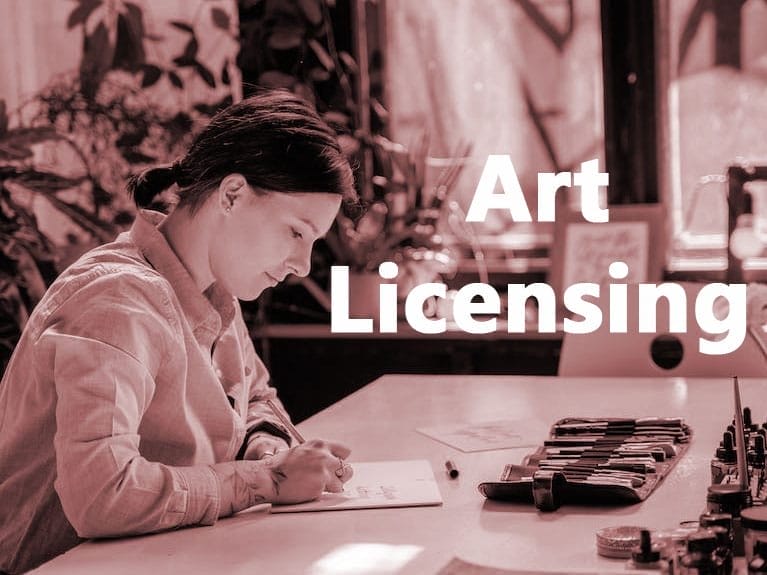Art licensing can be a game changer for artists. But what is it exactly? Simply put, it’s when an artist allows a company to use their artwork on products. This could be anything from a painting on a mug, a design on a t-shirt, or a pattern on a piece of fabric. The artist retains the copyright of their artwork, and the company pays to use it for a specified time.
This arrangement benefits both parties. For the artist, it offers a new revenue stream. Instead of selling a piece of art once, they can earn money each time a product with their art on it is sold. This is a form of passive income, meaning the artist earns money even after the work is done. For the company, they get to use unique, creative designs on their products which can make their items more appealing to customers.
Art licensing is a significant part of the art world. It’s a billion-dollar industry that involves artists from all over the globe. It’s a way for artists to reach a broader audience, as their work can be seen by anyone who buys or sees the product. That kind of exposure can lead to more opportunities for the artist.
But it’s not just about the money and exposure. Art licensing can also give artists more time to do what they love: create. Since the company handles the production and sales of the products, the artist is free to focus on creating new artwork.

Entering the world of art licensing requires understanding and navigating the industry. This includes knowing about licensing agreements, creating a portfolio, finding licensing opportunities, working with an agent, and more. Each of these topics will be discussed in the following sections to provide a comprehensive guide for artists considering art licensing.
To sum it up, art licensing is a way for artists to earn income, gain exposure, and focus on their creativity. It’s a big industry with lots of opportunities. But like any business venture, it requires knowledge, preparation, and determination. This guide aims to provide artists with the information they need to get started in art licensing. Now, let’s explore this exciting world in more detail.
Understanding Artwork Licensing Agreements

As an artist, when you step into the realm of art licensing, one of the first things you need to grasp is the concept of licensing agreements. These are official contracts between you, the artist, and the company that wants to use your artwork.
There are two main types of licensing agreements:
Each type of agreement has its own pros and cons. Direct licensing can give you more control over your artwork and potentially earn you more money, but it also means you have to handle all the negotiation and contract details yourself.
On the other hand, intermediary licensing can take some of the load off your shoulders, as the agency handles the negotiation and contract. But in return, they take a percentage of your earnings.
Here’s a quick table to help you remember key terms in the licensing world:
| Term | Description |
|---|---|
| Licensor | That’s you, the artist, giving permission to use your art. |
| Licensee | The company that wants to use your art on their products. |
| Art Licensing Agent | Someone who helps artists find licensing deals. |
| Licensing Work | The art pieces you allow companies to use. |
Key Components of a Typical Licensing Contract
- Duration: This is the length of time the company can use your artwork. It can range from one year to several years. It’s important to negotiate a duration that suits you.
- Exclusivity: This refers to whether the company is the only one allowed to use your artwork. If the contract is exclusive, you can’t license the same artwork to another company in the same product category during the contract period.
- Payment Structure: This is how you get paid. It could be a flat fee, where you get a one-time payment or royalties, where you get a percentage of each sale. For example, if you agree on a 5% royalty with a company that sells t-shirts with your design, you would get 5% of each t-shirt sale.
- Territory: This is the geographical area where the company can sell products with your artwork. It could be a specific country, several countries, or worldwide.
- Product Category: This specifies the type of products that can feature your artwork. It could be clothing, stationery, home décor, or any other category.
Understanding these components is vital in protecting your rights and interests as an artist. So, before signing any contract, ensure you fully understand the terms. If needed, seek legal advice. Remember, your artwork is your creation. It’s essential to ensure it’s used in a way that respects your rights and benefits you financially.
It’s important to note that every contract is unique and should be tailored to fit the specific agreement between you and the company. Some artists might prefer a shorter contract duration to allow for flexibility and the ability to license their work to other companies sooner. Others might prefer a longer contract duration for the stability it provides.
Exclusivity is another aspect that can vary greatly. An exclusive contract means that only the company you’re licensing your artwork to can use it, usually within a specific product category or geographical area. Non-exclusive contracts, on the other hand, allow you to license the same artwork to multiple companies. For instance, your artwork could be on coffee mugs in one store and on t-shirts in another.

How do I get Paid?
The payment structure is a key part of the contract. Some artists prefer a flat fee, which is a one-time payment for the use of their artwork. This can be beneficial if you need an immediate income, but it also means you won’t earn any more money if the product sells extremely well.
Royalties, which are a percentage of each sale, can provide a more sustained income over time. This means that the more products sold with your artwork, the more money you’ll make. For example, if your artwork is a hit and the company sells thousands of products featuring it, you’ll receive a percentage of each sale, which could add up to a significant amount.
The territory and product category should also be clearly defined in the contract. The territory refers to where the company can sell products with your artwork. The product category specifies what kind of products can feature your artwork.
Finally, protecting your intellectual property is a vital aspect of art licensing. By registering for a trademark, you can prevent others from using your work without permission. For instance, if you’ve created a unique logo or symbol, registering it as a trademark will provide legal protection.
Understanding licensing agreements is a key step in your art licensing journey. By knowing the types of agreements and the crucial components of a contract, you can ensure that you’re making informed decisions that protect your rights and benefit your career.
Remember, every artist’s journey is unique, and what works for one might not work for another. With knowledge and careful planning, you can navigate the world of art licensing and find the path that’s right for you.
Preparing to License Your Art
As you step into the world of art licensing, it’s important to be prepared. This involves creating a portfolio, building a unique style and brand, developing a brand book for pitching, and understanding the market.
Creating a portfolio is like putting together a visual resume. It shows potential companies what you can do and what they can expect if they choose to work with you. Your portfolio should include your best work, but remember, it’s not just about showcasing your talent. It’s also about showing how your artwork can be used on various products.
For instance, if you’re a painter and you want to license your work for use on home décor items, your portfolio could include pictures of your artwork on pillows, curtains, or wall art. If you’re a graphic designer interested in licensing your designs for use on clothing, you could include mock-ups of your designs on t-shirts, hoodies, or hats.
In the art world, having a unique style can set you apart. It’s what makes your work recognizable and different from the rest. Think about what makes your art unique. Is it your use of color? Your technique? The themes you explore? This unique style is a part of your brand.
Your brand is more than just your artwork. It’s also about how you present yourself and your work to the world. It includes your artist statement, your bio, your website, and even how you interact with potential clients and fans. A strong brand can make you more appealing to companies looking for artists to license from.
A brand book is like a guide to your brand. It includes information about you, samples of your work, and some mock-ups of your work on products. It’s a tool you can use when pitching to companies.
Your brand book should tell a story about you and your work. It should show companies why they should choose your work over others. For instance, if your artwork is vibrant and fun, your brand book could tell the story of how your artwork can bring joy and color to consumers’ lives.

Importance of market research and aligning with consumer demand
Understanding the market is key. You need to know what kind of artwork is in demand, what trends are popular, and who your target audience is.
For example, if you’re interested in licensing your work for use on children’s clothing, you need to know what colors, themes, and styles are popular in children’s fashion. If you’re targeting the home décor market, you need to keep up with interior design trends.
Preparing for art licensing involves creating a strong portfolio, building a unique style and brand, developing a brand book for pitching, and understanding the market. These steps can help you present yourself and your work in the best light, increasing your chances of success in the art licensing world.
Types of Art Licensing Opportunities
Art licensing opportunities can be broken down into 5 types as follows:

Product licensing is a common form of art licensing where your artwork is used on various products ranging from clothing and home décor items to stationery and more. This type of licensing allows tangible products to serve as a canvas for your art, bringing everyday items to life.
For instance, a simple white mug can become a piece of art with a beautiful design, or a plain t-shirt can become a fashion statement with a bold graphic.
When it comes to product licensing, it’s important to consider the style of your art and how it would translate onto a product. If your art is bold, colorful, and easily recognizable, it could be a good fit for product licensing. For example, a bold graphic design could look great on a t-shirt, while a beautiful watercolor landscape might be perfect for a throw pillow.

Print licensing involves your artwork being reproduced as prints, often sold as wall art or used in various other ways. This type of licensing is ideal for artists who create highly detailed work that can be appreciated in larger formats. It allows art lovers to own a piece of your work without owning the original, making art more accessible to a wider audience.
When matching your art to print licensing opportunities, consider the level of detail and the scale at which your work is best appreciated. If your art is highly detailed and looks good in large formats, print licensing could be a good fit. For instance, a detailed illustration could make a stunning wall print.
With the rise of digital media, digital licensing has become increasingly popular. This involves licensing your artwork for use in digital formats, such as online advertisements, websites, or even video games. This type of licensing allows artists to tap into the digital market and reach a global audience.
If you create digital art or if your artwork translates well to digital formats, consider digital licensing. For example, if you create whimsical character designs, they could be perfect for a video game.
Publishing licensing involves the use of your artwork in published materials, such as book covers, magazines, or other print publications. This type of licensing can enhance the visual appeal of a publication and capture the attention of potential readers.
If your artwork tells a story or can convey a concept visually, it could be a good fit for publishing licensing. A beautiful piece of art could bring a book cover to life, or a series of illustrations could enhance a magazine article.
Advertising licensing involves the use of your artwork in advertising campaigns. This can be a great way to gain exposure, as your work could be seen by a large audience. This type of licensing requires artwork that is eye-catching and can convey a message quickly.
When considering advertising licensing, think about whether your art is bold and attention-grabbing, and whether it can quickly convey a message. For example, a bold, attention-grabbing piece of art could make an advertising campaign stand out.
Finding Licensing Opportunities
The world of art licensing is vast and varied. Here are some key steps to finding opportunities that match your art and your goals.
Researching and targeting potential companies

Start by researching potential companies. Look for those that align with your style and the type of products you want to see your art on. For instance, if your art is whimsical and fun, a children’s clothing brand might be a good fit.
If your work is sophisticated and elegant, a home décor company might be more suitable. Online research can help you find these companies. Look at their products, their style, and the type of art they currently use.
Pitching and communication strategies
Once you’ve found potential companies, it’s time to pitch your work. This involves presenting your portfolio and explaining why your art is a good fit for their products.
Be professional, respectful, and enthusiastic. Show them how your art can add value to their products. Remember, it’s not just about selling your art, it’s about forming a partnership that benefits both parties.
For example, if you’re pitching to a clothing brand, you could create mock-ups showing how your designs would look on their clothes. This gives them a clear vision of the potential of your art.
Role of networking and industry events
Networking is a powerful tool in the art licensing world. It allows you to connect with other artists, potential clients, and industry professionals. These connections can lead to opportunities, collaborations, and valuable advice.
Industry events, like trade shows and art fairs, are great places for networking. They also give you the chance to see what’s trending in the industry and what companies are looking for.
Succeeding in Art Licensing

Landing a great licensing deal doesn’t happen overnight. Just like learning to create art took time and practice, finding success in the licensing industry requires patience. Many artists send their work to dozens of companies before they hear a “yes.”
For example, Jane, a budding artist, attended a trade show with her portfolio. She spoke to many potential licensors but didn’t get a deal right away. Instead of feeling defeated, she used the feedback, improved her art, and returned the next year. Her persistence paid off when a major licensee noticed her work and offered her a licensing deal.
Remember, every “no” is a step closer to that big break. Being consistent in your efforts and not giving up, even when things seem tough, can make all the difference.
Diversifying Income Streams
Relying on just one source of income can be risky. What if that one company you work with goes out of business? Diversifying means having multiple ways to earn money. In the world of art licensing, this could mean:
– Licensing your art to different types of products (like mugs, shirts, and posters).
– Working with an art licensing agent to find more opportunities.
– Creating your own art merchandise such as puzzles and selling them directly.
– Selling prints or originals of your art on the side.
Adapting to Trends and Being Open to Experimentation
The world of art is always changing. What’s popular today might not be tomorrow. To stay ahead, artists need to keep an eye on trends. Maybe watercolor designs are the latest craze, or perhaps retro patterns are making a comeback. Being open to trying new styles can lead to unexpected opportunities.
For instance, an artists guild might host a workshop on a new art technique. By attending and learning, you can add a fresh twist to your art. This adaptability can make your work stand out to licensors looking for the next big thing.
Importance of Professionalism and Meeting Deadlines
Imagine you start licensing with a big company. They’re counting on you to deliver art for their summer collection. If you miss the deadline, it could cost them a lot of money. That’s why being professional and punctual is so important in the licensing world.
Working with an Agent
An artist’s agent is like a superhero sidekick in the art industry. They help artists get their unique art in front of the right people. These agents have connections with many companies and know who might be interested in your original art.
They give artists a better chance to get their work on products in exchange for payment. For example, if you paint beautiful landscapes, an agent might know a company that wants that exact design for their new calendar line.
Pros and Cons of Working with an Agent
| Benefit | |
|---|---|
| Connections | Agents have ties to many companies you want to work with. |
| Negotiation Skills | They can negotiate deals, ensuring you get a fair royalty percentage. |
| Time-saving | Instead of you having to create a list of companies to approach, they already have a list ready. |
| Drawbacks | |
|---|---|
| Cost | Agents take a cut from your earnings. This is how they get paid for their work. |
| Loss of Control | The agent might make decisions that you might not fully agree with. |
| Not Always Necessary | For some artists, they find success without an agent. |
Selecting the Right Agent
Choosing the right agent is a big step. It’s like picking a partner for a dance. You want someone who understands your rhythm and can lead when needed. Here are some things to consider:
- Experience in Your Art Type: If you make sculptures, an agent who mostly deals with paintings might not be the best fit.
- Contract Negotiation Skills: You want someone who can get you the best deal.
- Good Communication: They should keep you in the loop and listen to your concerns.
Remember, while many artists don’t realize the benefits an agent can bring, it’s not for everyone. Some artists prefer the freedom of working on their own, while others enjoy the support an agent provides. It all depends on the type of artist you are and what you’re looking for in your career.
Financial Considerations in Art Licensing
Developing a Pricing Strategy

When you decide to license your art, one of the first things to think about is money. How much should you charge? This is where a pricing strategy comes in. A lot of artists look at what others in the art licensing industry are charging.
They also think about how popular their art is and where it will be used. For example, if a big company wants to put your art onto thousands of T-shirts, you might charge more than if a local shop wants to use it on a few mugs. Remember, it’s essential to know your worth and protect your work.
List of Factors to Consider in Pricing:
- Popularity of your art
- Where and how it will be used
- What others in the art licensing industry charge
Managing Finances and Understanding Tax Implications
Money matters can be tricky. When you sell art or license art, you earn money. But did you know that you might have to pay taxes on that money? It’s true. In the art licensing business, understanding taxes is key.
For instance, if you get a 10% royalty rate for every T-shirt sold with your design, you’ll need to set aside a part for taxes. It’s also a good idea to find an agent or join groups like the Graphic Artists Guild. They can give advice and help you navigate the world of art licensing.
Keeping Detailed Records
Write down every deal, every sale, and every contract. This way, you’ll know who owes you money and how much. Plus, if there’s ever a question about a deal, you’ll have the answers.
Example: Let’s say you made a type of licensing deal with an art publisher for your art licensing collection. They agreed to pay you a certain amount for every poster sold. After a big licensing trade event, they sold 500 posters. If you’ve kept detailed records, you can quickly check how much they owe you. Without those records, you might miss out on money you’ve earned.
Deciding If Art Licensing Is Right for You
Criteria to Consider
Art licensing can be an exciting journey, but it’s not for everyone. Before jumping in, it’s essential to think about a few things:
- Your Art’s Versatility: Can you imagine your art on a product? Maybe on a range of products like T-shirts, mugs, or posters? Some art pieces look great on canvas but might not fit on different products.
- Your Comfort Level: When it comes to licensing, you’ll work with companies and might not have full control over where your art goes. Are you okay with that?
- Your Business Skills: Art licensing isn’t just about art. It’s also about business. From contract negotiation to understanding the fine print, there’s a lot to learn.
- Your Goals: Do you want to create passive income? Or are you looking to become a household name? Knowing your goals can guide your decisions.
Evaluating Potential Return on Investment
Let’s talk money. One of the big questions artists have is, “Will I make money from this?” Here’s an example to help you understand:
Imagine you’re an artist named Alex. Alex decides to license a beautiful painting of a mountain. A company sees it and thinks it’d look great on their hiking gear. They strike an art licensing deal. Now, every art licensing agreement is unique, but let’s say this one has an agreement where the artist gives permission for the manufacturer to use the art for two years. In return, Alex gets a small amount of money every time a product with the mountain design sells.
In the first year, the hiking gear becomes super popular. Alex’s mountain is everywhere! By the end of the two years, Alex has made more money from the licensing deal than if they had chosen to sell the original painting just once.
Things to Remember:
- You can license the same art to different companies for different uses. For example, the mountain can be on hiking gear and also on calendars.
- Always protect your art. Before making any deal, consider registering with the copyright office.
- Look for other artists to follow. Learn from their experiences and see how they’ve made art licensing work for them.
In the end, deciding to enter the world of art licensing is a personal choice. It’s about balancing the joy of seeing your art on products with the business side of things. But with the right approach, it can be a rewarding adventure.






